
|
Biega Family Page
|
Computer Help
Special characters.
Viruses, Web pages
|
|
Central Europe
Cities, Countries, Info.
New!
|
|
History
Genealogy, History Essays New!
|
Maps
Cities, Countries, Historical
|
Museum AK
Museum of Polish Home Army
|
Photo Gallery
Poland, Warsaw, Cracow, Salzburg, Budapest New
|
Rydzyna
Castle and School
Sulkowski Foundation
Hotel
|
Sailing
all over the world
|
Syrena Press
13 Is My Lucky Number
Story of fighter in Warsaw Uprising in WW II
|

|
|
Contact us by Email
|
|
The coast of the Persian or Arabian Gulf is lined by small sheikdoms, or emirates - see Map. Some such as Kuwait, Bahrain and Dubai had prospered for hundreds of years as small trading ports into which the lateen rigged dhows carried goods from India to the valley of the Euphrates and for trade with the Bedouin sheiks of Arabia and transit on to Europe. Bahrain and Dubai were also bases for pearl divers and sometimes for pirates. After World War I through World War II the British had pacified the area and maintained small military bases to safeguard the important sea routes to India.
Oil had been discovered first in Iran. then Bahrain, in the late 1930's, just before the discovery also in the coastal area belonging to the Saudi kingdom just opposite the island of Bahrain. In 1948 the rich oilfields of Kuwait came on stream. Then oil and gas were discovered in the sheikdoms of Abu Dhabi and Qatar in 1958, finally off the coast of Dubai in 1969.
With a long history of trade, the rulers of these emirates were much more tolerant than their Saudi cousins. Drinking in western hotels, clubs and restaurants was permitted, as was mixed swimming at the hotel or club pools. Although visas for long term residents were just as difficult to obtain as those for Saudi Arabia, visas for short term visits were granted at the airports upon arrival. In some cases local sponsorship was required, but usually hotels arranged to sponsor anyone who had made prior reservations.
Bahrain with its long history as a trading post was the most liberal. Visas were granted freely for stays of up to a week, with a minimum of formalities. There was a liquor store right at the airport and beer and wines were served in the airport restaurants to any one. As Bahrain was only ten minutes by air from Dhahran, thirsty Saudis flocked into the airport, some of them staying there all day long guzzling beer and having to be literally carried to the plane for the return flight in the evening. The principal city of this island, Al-Manama, was a thriving metropolis, already well developed at the time of my first visit, having been harvesting its oil reserves already for 40 years. The narrow streets in the old part of town were lined with shops selling anything the heart could desire, from local rugs and pottery and cheap shirts to Japanese radios, calculators, cameras and cassette players.
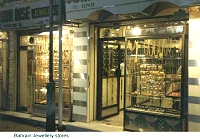 But the most fascinating were the numerous jewelry stores with windows crammed with gold bracelets, necklaces, earrings and rings. Nothing was less than 18 carat gold, and most of the bracelets and necklaces were 22 or even 24 carat. As always one haggled over the price. The daily raw gold price per gram was posted in most shops. But then the price per gram for an item increased depending upon the amount of intricate workmanship, and this was this number which was the subject to the haggling. Once a price was agreed, the item was weighed and the final price calculated by multiplying the agreed price per gram times the actual weight. Every Arabian city had its gold soukhs, but none as extensive as the one in Bahrain. Here too one could strike the best bargains because the choice and competition was so large.
But the most fascinating were the numerous jewelry stores with windows crammed with gold bracelets, necklaces, earrings and rings. Nothing was less than 18 carat gold, and most of the bracelets and necklaces were 22 or even 24 carat. As always one haggled over the price. The daily raw gold price per gram was posted in most shops. But then the price per gram for an item increased depending upon the amount of intricate workmanship, and this was this number which was the subject to the haggling. Once a price was agreed, the item was weighed and the final price calculated by multiplying the agreed price per gram times the actual weight. Every Arabian city had its gold soukhs, but none as extensive as the one in Bahrain. Here too one could strike the best bargains because the choice and competition was so large.
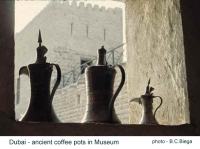 Bahrain is the largest island of an archipelago, roughly 25 miles long from north to south and about 9 miles wide. Remains of a Stone Age settlement have been discovered. It is historically the oldest of the Persian Gulf sheikdoms, having been a trading post since the 14th century, even though it does not possess a sheltered harbor. It had a fishing industry and was a center for pearl divers. The liberal attitude of the sheikhs, under the protection of the British by treaty since 1860, allowed it to become the dominant commercial and financial center of the region. Its rapid growth began with the discovery of oil in 1932. Now its own oil reserves are running out but industry, banking and commerce maintain its wealth. A causeway providing a road connection with the Saudi Arabia mainland was finally completed in the early 1980's, after considerable delays due to the objections from the Saudi Wahabi clerics, who did not wish to make access to the relative freedom of the island to be made easier for Saudi citizens. Bahrain is the largest island of an archipelago, roughly 25 miles long from north to south and about 9 miles wide. Remains of a Stone Age settlement have been discovered. It is historically the oldest of the Persian Gulf sheikdoms, having been a trading post since the 14th century, even though it does not possess a sheltered harbor. It had a fishing industry and was a center for pearl divers. The liberal attitude of the sheikhs, under the protection of the British by treaty since 1860, allowed it to become the dominant commercial and financial center of the region. Its rapid growth began with the discovery of oil in 1932. Now its own oil reserves are running out but industry, banking and commerce maintain its wealth. A causeway providing a road connection with the Saudi Arabia mainland was finally completed in the early 1980's, after considerable delays due to the objections from the Saudi Wahabi clerics, who did not wish to make access to the relative freedom of the island to be made easier for Saudi citizens.
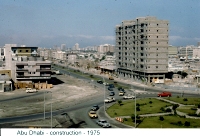 The United Arab Emirates is a federation of seven Emirates created in 1971 upon the withdrawal of British forces, to further their development and security.
The United Arab Emirates is a federation of seven Emirates created in 1971 upon the withdrawal of British forces, to further their development and security.
Abu Dhabi, is the largest and the capital of the Federation. Once it was a small village, home to pearl fishers. The discovery of oil suddenly precipitated a fabulous increase of wealth. Today it is a bustling modern metropolis with a per capita income higher than that of most north American states.
When I first came here in 1973 it was in the throes of frantic building. The only accommodation that I could find was a room on the fifth floor of a hotel that was still under construction. I slept on a cot in a room that did not yet have a window, only an opening in the brickwork. However a shower head and a flush toilet had been installed in the space that was to be the bathroom, so I enjoyed modern amenities! I rode up and down the five floors in a construction elevator. As I recall I had to pay the equivalent of US$30 per night for this very basic space, at the time more than the average price of hotel rooms in America.
The most interesting of the Emirates is Dubai.
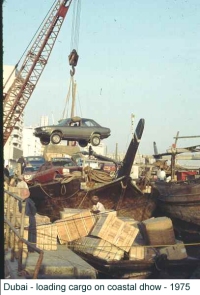 The long sheltered inlet, called the Creek, had been the base for a large trading port and ship-building for over 200 years. Today, it is considerably expanded but old dhows still provide the main transportation to all the small harbors of the Middle East. The Creek was defended by a large fort (now a museum) which guarded it against intrusions by pirates. The Sheiks of Dubai were the first to encourage trade and provide a friendly base for foreign traders and a free trade zone with relaxed laws allowing resorts and hotels to provide amenities such as bars and sport facilities for non-Muslim visitors. In the 1930s Dubai was a nightly stopover for the British Imperial Airways flying boats on the route from England to India and Australia and there are many souvenirs of those days in the museum located in the old fort.
The long sheltered inlet, called the Creek, had been the base for a large trading port and ship-building for over 200 years. Today, it is considerably expanded but old dhows still provide the main transportation to all the small harbors of the Middle East. The Creek was defended by a large fort (now a museum) which guarded it against intrusions by pirates. The Sheiks of Dubai were the first to encourage trade and provide a friendly base for foreign traders and a free trade zone with relaxed laws allowing resorts and hotels to provide amenities such as bars and sport facilities for non-Muslim visitors. In the 1930s Dubai was a nightly stopover for the British Imperial Airways flying boats on the route from England to India and Australia and there are many souvenirs of those days in the museum located in the old fort.
The ancient houses in the old city were built with a remarkable system for cooling, Large towers had wide openings facing the four directions. Ducts led down from these openings into the building below. The blowing wind caused natural circulation of air inside the living quarters.
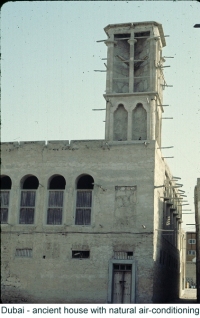 The discovery of oil offshore in 1966 spurred a rapid expansion. When I first came here in 1973 there was only one first class hotel to Western standards, the Sheraton. It was located quite a distance from the old city at the end of the Corniche, a two-mile long waterfront promenade. Needless to say there was little hope of obtaining a reservation. All the rooms were booked an a permanent basis by the numerous companies engaged in the feverish building of off-shore drilling platforms, refineries, roads, port facilities and all the other infrastructure for the rapidly growing industry. I was only able to find space in an older hotel, but had to share a room with a construction worker. Fortunately he worked nights and slept during the day, so I only met him in passing.
The discovery of oil offshore in 1966 spurred a rapid expansion. When I first came here in 1973 there was only one first class hotel to Western standards, the Sheraton. It was located quite a distance from the old city at the end of the Corniche, a two-mile long waterfront promenade. Needless to say there was little hope of obtaining a reservation. All the rooms were booked an a permanent basis by the numerous companies engaged in the feverish building of off-shore drilling platforms, refineries, roads, port facilities and all the other infrastructure for the rapidly growing industry. I was only able to find space in an older hotel, but had to share a room with a construction worker. Fortunately he worked nights and slept during the day, so I only met him in passing.
At that time it took four hours to travel between the two cities along a pot-holed road lined with the remains of wrecked cars. At my last visit 12 years later, this had become a four-lane limited access expressway. One had a pick of luxurious hotels in all cities with bars and swimming pools, good restaurants, albeit at prices equal to those in New York.
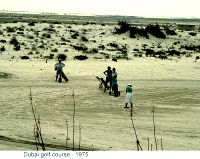 A comfortable country club hosted a golf-course. However there was no grass. The greens were carefully leveled and compacted sand. The players used red balls. (On TV in 2005 I watched a regional golf championship at this same club, but now the fairways and greens were beautiful grass!).
NOTES
A comfortable country club hosted a golf-course. However there was no grass. The greens were carefully leveled and compacted sand. The players used red balls. (On TV in 2005 I watched a regional golf championship at this same club, but now the fairways and greens were beautiful grass!).
NOTES
1.
Return to top of page.
Continue to Part 2 - Kuwait, Qatar in the 1970s
Return to History Essays index.
|
|








